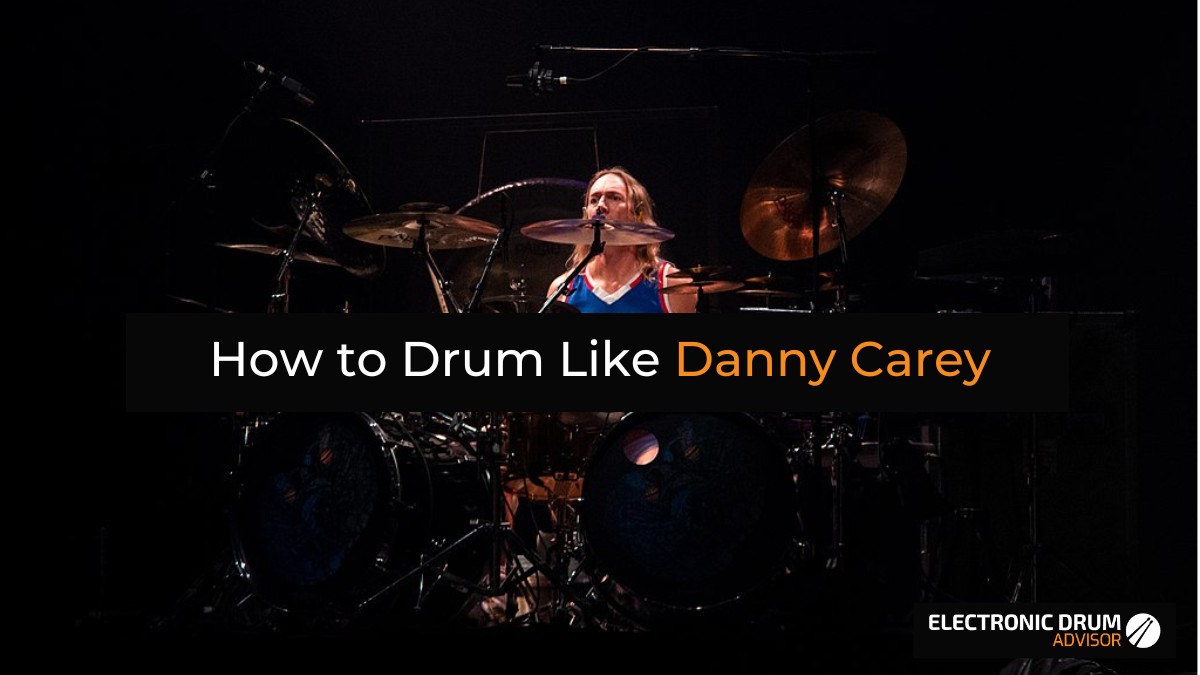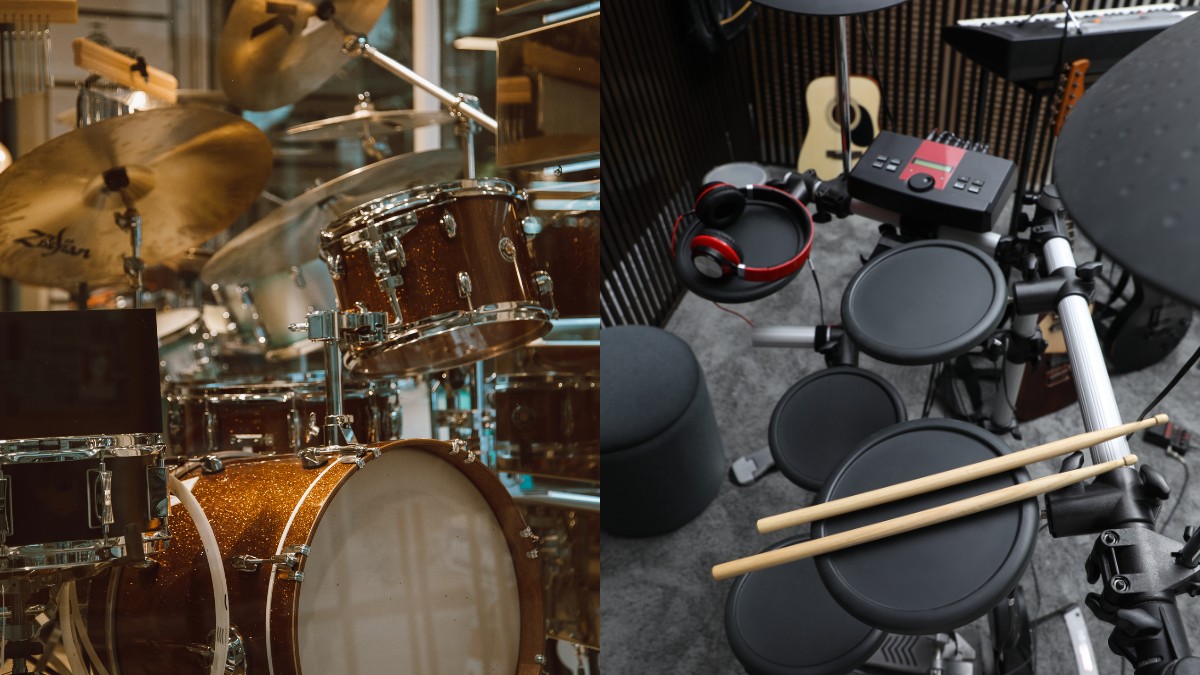How To Drum Like Danny Carey (6 Tips)

Formed in California in 1990, Tool is a progressive rock band known for its intricate approach to songwriting and critically-acclaimed albums. Their ambitious take on the prog sound has turned them into worldwide cult legends. Their songs are unique, mathematical, and very technically challenging—three traits that are best shown in the playing style of their revered drummer, Danny Carey.
Carey is universally regarded as one of the best drummers in the world right now. Drumeo listed him as one of the 50 best drummers of all time. Playing like Carey is not an easy task, but learning about his techniques, work ethic, musical approaches, and general mindset is the way to start.
Before taking a closer look into Carey’s drumming methods, check out five of the reasons why he is considered to be a musical genius:
Drumeo also has plenty of great notations and drumless tracks from the band Tool, and you can get access to them with this free 30-day trial of Drumeo. They also have some great lessons related to Danny Carey’s drumming and tips on how to play Tool songs.
Contents
1. Count like a pro: Danny Carey’s mathematical approach to drumming
Carey once stated that he wanted to be a professional basketball player. However, if he wasn’t a drumming god, he would probably make for a great mathematician. Much due to his drumming style, the discography of Tool reads like a complex equation, filled with odd time signatures, devastatingly convoluted polymeters, and demanding polyrhythms.
Carey’s mathematical approach to music can be heard and seen everywhere, even in the way he sets up his drum kit. While many top drummers are known to set up their kits symmetrically, Carey takes the concept to a whole another level, showing a quasi-obsessive perfectionism towards drum positioning.
Tool’s music goes heavy on the math! There is no lack of examples of complex odd time signatures in the groups discography, from the 5/8 and 7/8 interchanges in “Schism” to the incredibly challenging 7-over-3 polyrhythm of “Invincible.” In “Eulogy,” Carey plays a hi-hat pattern in groups of three over a steady 4/4 rock beat that takes a whole three bars to resolve—all while sounding incredibly groovy.
Carey is also a master of the polymeter, which refers to his ability to play in a different time signature than the time signature that the rest of the band is following. Still, Carey somehow never sounds out of place. Like an advanced mathematician, he is able to take on the most intricate formulas while still reaching a logical result everybody (and Tool’s fanbase in particular) can understand.
2. Make it happen: Danny Carey’s conceptual approach to drumming
Far from being just a “numbers guy,” Carey is known to be fascinated with spiritualism. While that doesn’t show directly in his drumming, it’s somewhat visible throughout Tool’s discography. His passion for the esoteric arts can also be associated with his conceptual approach to drumming, which takes on supernatural levels in tracks such as “Lateralus” and “Pneuma.”
In “Lateralus,” Carey follows a series of interchanging time signatures that make up the famous Fibonacci sequence. In “Pneuma,” he uses three different odd time signatures that lose a beat every other bar; after all, the song goes from 12/8 to 11/8 to 10/8.
While both examples can also be described as “mathematical,” that’s simply because all drumming can be put into numbers in the end. What these two tracks (and many others in Tool’s catalog) reveal is Carey’s disposition for conceptualizing his playing. He is not following the Fibonacci sequence by accident—he is doing it because he wanted to make it happen and he was sure to do so!
Talking about his approach to composition in a 2012 interview, Carey stated “I never wanted just to play beats. I wanted to play the songs.” Serving the music instead of the instrument is a trait of many accomplished musicians, including the great late Neil Peart, but Carey takes this concept to another level. He’s not just playing the songs, but he’s playing actual ideas that go beyond the realms of music and sound.
3. Get the Danny Carey sound
Part of what makes every great drummer distinctive is their approach to sound. Carey’s drumming is recognizable not only because of his style of playing but also because of some of the sonic approaches he has taken on repeatedly over the years.
One of the best-known examples is his reliance on tom-based drum grooves. “Jambi” is but one of the many examples one can find in Tool’s discography. By using the toms as the driving sound in some of his best drum patterns, Carey somehow finds the freedom he needs to craft high-complexity rhythms that don’t lose on any of the catchiness.
Another characteristic Carey move is to play with the snare wires turned off, making for a less open, more muffled sound. “The Patient” is but one of the many tracks in which the great Tool drummer applies this technique.
As far as gear goes, Carey relies mainly on a Sonor SQ2 drum series drum kit.
4. Get inspiration from outside of your genre
It’s a capital sin of rock musicians: only listening to and relying on rock music influences. Part of what separates run-of-the-mill rock musicians from acclaimed rockstars such as Carey is the fact that the latter love going outside of their genre to find new, interesting ways of playing.
Carey has surely done this. In one of his Grammy Award acceptance speeches, he listed the great jazz drummer Tony Williams as one of his main influences. Other jazz greats who have inspired Carey include the likes of Billy Cobham, Lenny White, and, of course, buddy rich. In Tool’s catalog, Carey’s jazzy backbone is best shown by his ride-cymbal playing.
For inspiration, Carey has also looked outside of Western music. He reportedly studied tabla with the renowned Bengali tabla player Aloke Dutta and was sure to incorporate the instrument in his compositions. “Disposition” is perhaps one of the clearest example of tablas being used in a Tool song, but they’re all over the place! While Carey recorded the song using real tablas, he relies on his Mandala Pads to trigger his tabla sounds whenever he is performing in front of an audience.
5. Practice differently
Practice makes perfection, and practicing differently is the way to go to get unique results. Carey would probably agree, as he’s known to do something most drummers would never think of: practicing rudiments with his feet to improve his double-bass playing.
Sadly, Carey never opened up about everything he does while practicing, but his lower-limb rudiment tip should be enough to get us going. Before learning the drums, Carey studied percussion by learning the snare drum. That’s probably why he loves tom-based drum grooves so much, and that’s surely why he knows how important learning rudiments can be for a drummer’s development.
To get into the Danny-Carey mode, try to play rudiments using only your feet and incorporate new, original techniques into your drum practice.
6. Let yourself go
All shreds of evidence seem to show that Carey is obsessed with numbers, perfection, and getting it right. However, the drummer of tool admitted in an interview that he doesn’t like to record or perform using a click track and that he feels that some of the musicians who do—including Judas Priest’s former drummer Dave Holland—end up sounding “weird.”
Reportedly, Tool never uses backing tracks for anything, and Carey would surely like it to continue that way. In the same interview, he stated that “You have to put yourself in this environment that’s vulnerable and go off in the moment.” Wow! Is this the same guy who made a song using the Fibonacci sequence?
Surprisingly enough, Carey is all about being natural, playing fluidly, and allowing yourself to get off tempo sometimes. What’s ironic is that, beyond being very precise, his playing is what most (normal) drummers would describe as incredibly click-dependent. Nevertheless, it’s always a good idea to listen to the master and let yourself go!
Conclusion
The path to becoming a drumming genius sure ain’t easy, but you won’t get there unless you’re ready to learn from the best. Surely among the most talented drummers alive, Carey has some pretty interesting and unique approaches to drumming, composing, and practicing.


After interiorizing some of the concepts that make Carey’s playing so great and distinctive, it’s important to put them into action by trying to mimic some of his best-known grooves. Even doing that is no easy task but, luckily, there is plenty of high-quality content online that can help you on that journey.
The drummer’s website Drumeo is probably the best place to get familiar with Danny Carey, and they even have a few exclusive lessons featuring Tool’s music with drummer Aaron Edgar; check them out here.
Finally, check out this great Drumeo video on the “8 TOOL Songs You Always Wanted To Play On Drums,” which includes high-detailed instructions and sheet music on how to perform Tool tracks as popular as “The Grudge,” “Sober,” “Eulogy,” “Forty Six & 2,” and “Rosetta Stoned” on your favorite instrument:
Featured Image by: Selbymay, CC BY-SA 4.0, via Wikimedia Commons








